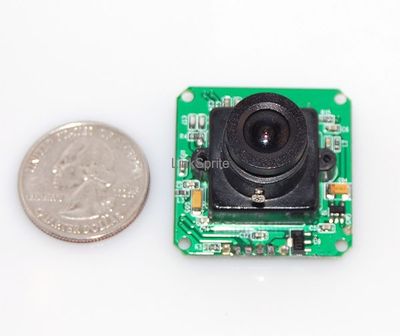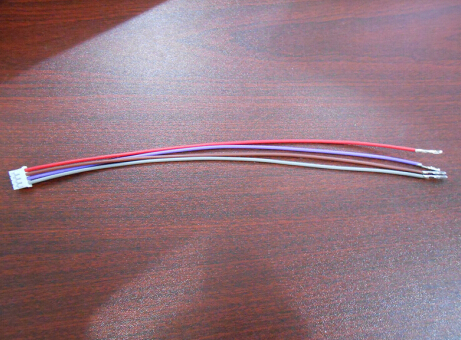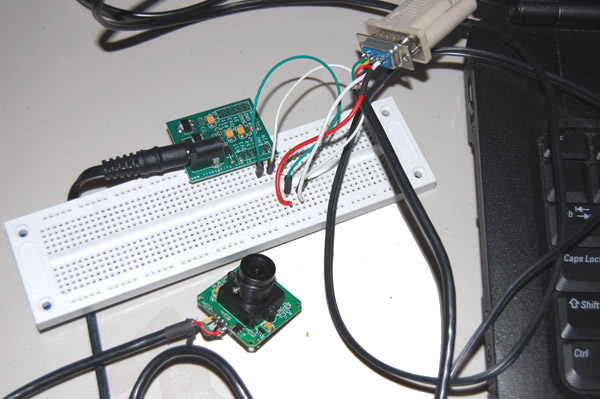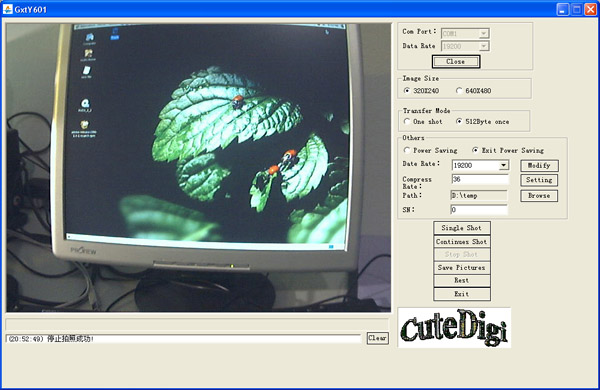Difference between revisions of "JPEG Color Camera Serial Interface (RS232 level)"
Katherine.d (talk | contribs) |
Yajuan.dai (talk | contribs) (→Package List) |
||
| (14 intermediate revisions by 3 users not shown) | |||
| Line 1: | Line 1: | ||
| + | == Description == | ||
| + | |||
LS-Y201 is LinkSprite’s new generation serial port camera module. It can captures high resolution pictures using the serial port. LS-Y201 is a modular design that outputs JPEG images through UART, and can be easily integrated into existing design. | LS-Y201 is LinkSprite’s new generation serial port camera module. It can captures high resolution pictures using the serial port. LS-Y201 is a modular design that outputs JPEG images through UART, and can be easily integrated into existing design. | ||
| − | Model:CAM_JPEG_RS232 | + | == Package List == |
| + | *1 X [CAM_JPEG_RS232][201201002] | ||
| + | *1 X [IT_CAM_CAB ][AA101102] | ||
| + | |||
| + | |||
| + | |||
| + | Model: [CAM_JPEG_RS232][201201002] | ||
[[File:camerattl.jpg | 400px]] | [[File:camerattl.jpg | 400px]] | ||
| + | |||
| + | Cable included: [IT_CAM_CAB ][AA101102] | ||
| + | |||
| + | [[File:IT_CAM_IR_CAB-1.jpg]] | ||
== Features == | == Features == | ||
| − | |||
| Line 49: | Line 60: | ||
== Usage == | == Usage == | ||
| + | === Hardware Installation === | ||
| + | '''Evaluation Setup''' | ||
| + | |||
| + | [[File:evasetup.jpg]] | ||
| + | |||
| + | === Programming === | ||
| + | [[File:evascreenshot.jpg]] | ||
| + | |||
| + | *Step 1: Click Open COM | ||
| + | *Step 2: Click Single Shot. | ||
| + | |||
| + | '''''Arduino sample code provided''''' | ||
| + | |||
| + | <syntaxhighlight lang="c"> | ||
| + | |||
| + | /* Linksprite */ | ||
| + | |||
| + | #include <NewSoftSerial.h> | ||
| + | |||
| + | byte incomingbyte; | ||
| + | NewSoftSerial mySerial(4,5); //Configure pin 4 and 5 as soft serial port | ||
| + | int a=0x0000,j=0,k=0,count=0; //Read Starting address | ||
| + | uint8_t MH,ML; | ||
| + | boolean EndFlag=0; | ||
| + | |||
| + | void SendResetCmd(); | ||
| + | void SendTakePhotoCmd(); | ||
| + | void SendReadDataCmd(); | ||
| + | void StopTakePhotoCmd(); | ||
| + | |||
| + | void setup() | ||
| + | { | ||
| + | Serial.begin(19200); | ||
| + | mySerial.begin(38400); | ||
| + | } | ||
| + | |||
| + | void loop() | ||
| + | { | ||
| + | SendResetCmd(); | ||
| + | delay(4000); //After reset, wait 2-3 second to send take picture command | ||
| + | |||
| + | SendTakePhotoCmd(); | ||
| + | |||
| + | while(mySerial.available()>0) | ||
| + | { | ||
| + | incomingbyte=mySerial.read(); | ||
| + | |||
| + | } | ||
| + | byte a[32]; | ||
| + | |||
| + | while(!EndFlag) | ||
| + | { | ||
| + | j=0; | ||
| + | k=0; | ||
| + | count=0; | ||
| + | SendReadDataCmd(); | ||
| + | |||
| + | delay(25); | ||
| + | while(mySerial.available()>0) | ||
| + | { | ||
| + | incomingbyte=mySerial.read(); | ||
| + | k++; | ||
| + | if((k>5)&&(j<32)&&(!EndFlag)) | ||
| + | { | ||
| + | a[j]=incomingbyte; | ||
| + | if((a[j-1]==0xFF)&&(a[j]==0xD9)) //Check if the picture is over | ||
| + | EndFlag=1; | ||
| + | j++; | ||
| + | count++; | ||
| + | } | ||
| + | } | ||
| + | |||
| + | for(j=0;j<count;j++) | ||
| + | { if(a[j]<0x10) | ||
| + | Serial.print("0"); | ||
| + | Serial.print(a[j],HEX); | ||
| + | Serial.print(" "); | ||
| + | } //Send jpeg picture over the serial port | ||
| + | Serial.println(); | ||
| + | } | ||
| + | while(1); | ||
| + | } | ||
| + | |||
| + | //Send Reset command | ||
| + | void SendResetCmd() | ||
| + | { | ||
| + | mySerial.print(0x56, BYTE); | ||
| + | mySerial.print(0x00, BYTE); | ||
| + | mySerial.print(0x26, BYTE); | ||
| + | mySerial.print(0x00, BYTE); | ||
| + | } | ||
| + | |||
| + | //Send take picture command | ||
| + | void SendTakePhotoCmd() | ||
| + | { | ||
| + | mySerial.print(0x56, BYTE); | ||
| + | mySerial.print(0x00, BYTE); | ||
| + | mySerial.print(0x36, BYTE); | ||
| + | mySerial.print(0x01, BYTE); | ||
| + | mySerial.print(0x00, BYTE); | ||
| + | } | ||
| + | |||
| + | //Read data | ||
| + | void SendReadDataCmd() | ||
| + | { | ||
| + | MH=a/0x100; | ||
| + | ML=a%0x100; | ||
| + | mySerial.print(0x56, BYTE); | ||
| + | mySerial.print(0x00, BYTE); | ||
| + | mySerial.print(0x32, BYTE); | ||
| + | mySerial.print(0x0c, BYTE); | ||
| + | mySerial.print(0x00, BYTE); | ||
| + | mySerial.print(0x0a, BYTE); | ||
| + | mySerial.print(0x00, BYTE); | ||
| + | mySerial.print(0x00, BYTE); | ||
| + | mySerial.print(MH, BYTE); | ||
| + | mySerial.print(ML, BYTE); | ||
| + | mySerial.print(0x00, BYTE); | ||
| + | mySerial.print(0x00, BYTE); | ||
| + | mySerial.print(0x00, BYTE); | ||
| + | mySerial.print(0x20, BYTE); | ||
| + | mySerial.print(0x00, BYTE); | ||
| + | mySerial.print(0x0a, BYTE); | ||
| + | a+=0x20; //address increases 32,set according to buffer size | ||
| + | } | ||
| + | |||
| + | void StopTakePhotoCmd() | ||
| + | { | ||
| + | mySerial.print(0x56, BYTE); | ||
| + | mySerial.print(0x00, BYTE); | ||
| + | mySerial.print(0x36, BYTE); | ||
| + | mySerial.print(0x01, BYTE); | ||
| + | mySerial.print(0x03, BYTE); | ||
| + | } | ||
| + | |||
| + | </syntaxhighlight> | ||
| + | |||
| + | |||
| + | == Resource == | ||
| + | *[https://s3.amazonaws.com/linksprite/camera/JPEG_camera_uartinterface_TTL/LSY201evaluationsoftware.exe Evaluation Software] | ||
| + | *[https://s3.amazonaws.com/linksprite/camera/JPEG_camera_uartinterface_TTL/LSY201.rar Linksprite Open Source Code for X86] | ||
| + | *[https://s3.amazonaws.com/linksprite/camera/JPEG_camera_uartinterface_TTL/JPEG_UART_camera_tutorial.pdf Tutorial at LinkSprite] | ||
| + | *[https://s3.amazonaws.com/linksprite/camera/JPEG_camera_uartinterface_TTL/LS-Y201+product+Specifications.pdf LS-201_product_specification] | ||
Latest revision as of 09:51, 13 August 2014
Contents
Description
LS-Y201 is LinkSprite’s new generation serial port camera module. It can captures high resolution pictures using the serial port. LS-Y201 is a modular design that outputs JPEG images through UART, and can be easily integrated into existing design.
Package List
- 1 X [CAM_JPEG_RS232][201201002]
- 1 X [IT_CAM_CAB ][AA101102]
Model: [CAM_JPEG_RS232][201201002]
Cable included: [IT_CAM_CAB ][AA101102]
Features
Application Ideas
- Different image capture systems
- Environmental monitoring
- Industry monitoring
- Medical equipment
- Video phone
- Security
- Vehicle based GPS
Cautions
The warnings and wrong operations possible cause dangerous.
Schematic
Specification
- VGA/QVGA/160*120 resolution
- Support capture JPEG from serial port
- Default baud rate of serial port is 38400
- DC 3.3V or 5V power supply
- Size 32mm X 32mm
- Current consumption: 80-100mA
- The pin near C03 is AV output pin, which is an analog output pin.
Pin definition and Rating
Mechanic Dimensions
Usage
Hardware Installation
Evaluation Setup
Programming
- Step 1: Click Open COM
- Step 2: Click Single Shot.
Arduino sample code provided
<syntaxhighlight lang="c">
/* Linksprite */
- include <NewSoftSerial.h>
byte incomingbyte; NewSoftSerial mySerial(4,5); //Configure pin 4 and 5 as soft serial port int a=0x0000,j=0,k=0,count=0; //Read Starting address uint8_t MH,ML; boolean EndFlag=0;
void SendResetCmd(); void SendTakePhotoCmd(); void SendReadDataCmd(); void StopTakePhotoCmd();
void setup() {
Serial.begin(19200); mySerial.begin(38400);
}
void loop() {
SendResetCmd();
delay(4000); //After reset, wait 2-3 second to send take picture command
SendTakePhotoCmd();
while(mySerial.available()>0)
{
incomingbyte=mySerial.read();
}
byte a[32];
while(!EndFlag)
{
j=0;
k=0;
count=0;
SendReadDataCmd();
delay(25);
while(mySerial.available()>0)
{
incomingbyte=mySerial.read();
k++;
if((k>5)&&(j<32)&&(!EndFlag))
{
a[j]=incomingbyte;
if((a[j-1]==0xFF)&&(a[j]==0xD9)) //Check if the picture is over
EndFlag=1;
j++;
count++;
}
}
for(j=0;j<count;j++)
{ if(a[j]<0x10)
Serial.print("0");
Serial.print(a[j],HEX);
Serial.print(" ");
} //Send jpeg picture over the serial port
Serial.println();
}
while(1);
}
//Send Reset command void SendResetCmd() {
mySerial.print(0x56, BYTE);
mySerial.print(0x00, BYTE);
mySerial.print(0x26, BYTE);
mySerial.print(0x00, BYTE);
}
//Send take picture command void SendTakePhotoCmd() {
mySerial.print(0x56, BYTE);
mySerial.print(0x00, BYTE);
mySerial.print(0x36, BYTE);
mySerial.print(0x01, BYTE);
mySerial.print(0x00, BYTE);
}
//Read data void SendReadDataCmd() {
MH=a/0x100;
ML=a%0x100;
mySerial.print(0x56, BYTE);
mySerial.print(0x00, BYTE);
mySerial.print(0x32, BYTE);
mySerial.print(0x0c, BYTE);
mySerial.print(0x00, BYTE);
mySerial.print(0x0a, BYTE);
mySerial.print(0x00, BYTE);
mySerial.print(0x00, BYTE);
mySerial.print(MH, BYTE);
mySerial.print(ML, BYTE);
mySerial.print(0x00, BYTE);
mySerial.print(0x00, BYTE);
mySerial.print(0x00, BYTE);
mySerial.print(0x20, BYTE);
mySerial.print(0x00, BYTE);
mySerial.print(0x0a, BYTE);
a+=0x20; //address increases 32,set according to buffer size
}
void StopTakePhotoCmd() {
mySerial.print(0x56, BYTE);
mySerial.print(0x00, BYTE);
mySerial.print(0x36, BYTE);
mySerial.print(0x01, BYTE);
mySerial.print(0x03, BYTE);
}
</syntaxhighlight>



